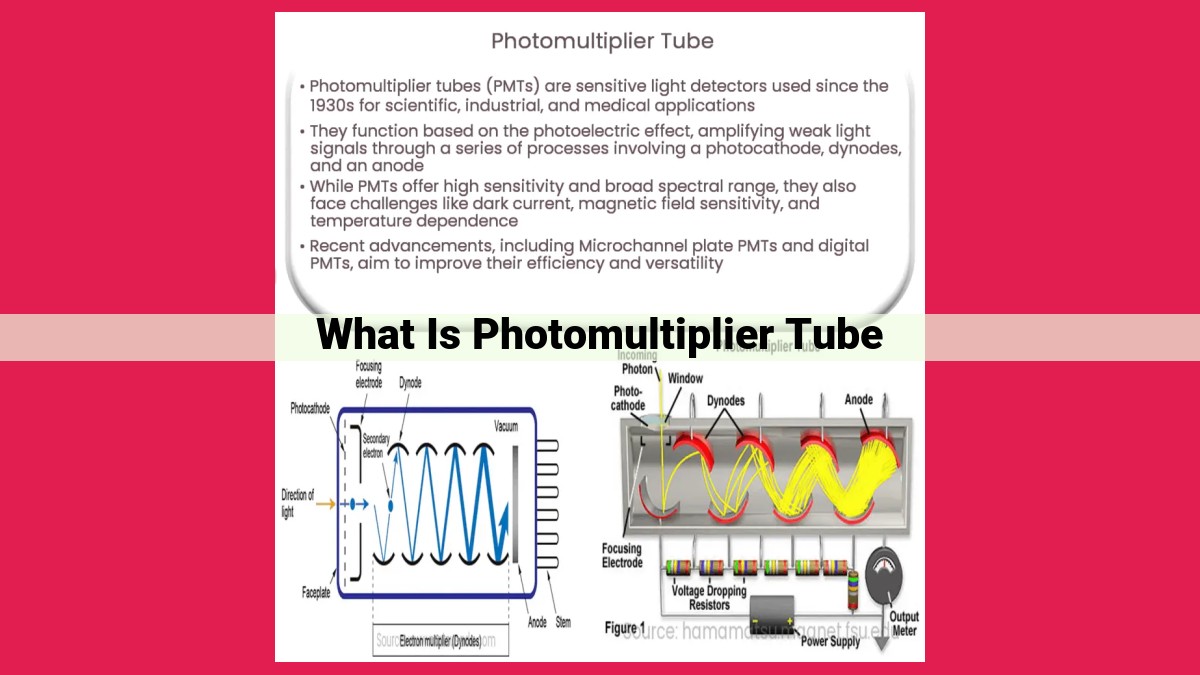Enhanced Light Detection: Unveiling The Power Of Photomultiplier Tubes

A photomultiplier tube (PMT) is a highly sensitive photodetector that amplifies faint light signals by converting them into measurable electrical currents. It consists of a photocathode that emits electrons upon photon absorption, dynodes that multiply these electrons through successive collisions, and an anode that collects the resulting amplified electron signal. PMTs provide exceptional gain, low noise, and high quantum efficiency, making them crucial in applications requiring the detection and amplification of extremely weak light signals, such as nuclear physics, particle physics, astronomy, medical imaging, and spectroscopy.
Unveiling the Secrets of Photomultiplier Tubes (PMTs)
In the realm of light detection, where ordinary sensors falter and the faintest glimmers demand exceptional sensitivity, there lies a beacon of innovation: the photomultiplier tube (PMT). These remarkable devices are not mere photodetectors but rather extraordinary amplifiers of light, transforming the faintest of signals into measurable currents.
Imagine a world where darkness reigns supreme. Enter the PMT, a knight in shining armor, capable of illuminating the tiniest flicker of light, like a celestial beacon piercing through the veil of night. Its purpose is noble: to make the invisible visible, unlocking a hidden world of photons and electrons.
At the heart of the PMT lies a symphony of components, each playing a vital role in this extraordinary alchemy of light amplification. First, the photocathode, a sensitive surface that greets photons like a welcoming host. As these photons arrive, they surrender their energy, liberating electrons that embark on an electrifying journey.
These freed electrons, now brimming with potential, encounter a series of dynodes, meticulously arranged in a cascade-like structure. Each dynode, like a relay runner, amplifies the electron current with astonishing precision, multiplying the initial signal a millionfold or even more.
This cascade of amplification within the PMT is nothing short of remarkable. The output signal, now a torrent of electrons, emerges from the anode like a triumphant army, carrying a wealth of information about the initial light signal. It’s a testament to the PMT’s unrivaled ability to transform the faintest of light into a measurable current, making it an invaluable tool in a myriad of scientific fields.
Delving into the Core of PMT Concepts: Unveiling the Secrets of Light Amplification
Photomultiplier Tubes (PMTs) are extraordinary devices that amplify light signals to astonishing levels, opening up a realm of possibilities in scientific research and technological advancements. To fully appreciate the capabilities of PMTs, let’s embark on a journey to unravel the key concepts that govern their operation.
Gain: The Amplification Factor of Electron Signals
Imagine a tiny spark, a flash of light so faint that it would vanish unnoticed by most detectors. But not by a PMT. Its gain is its secret weapon, empowering it to amplify this feeble signal into a cascade of electrons, like a symphony of light. This remarkable amplification factor allows PMTs to detect even the most elusive photons.
Dark Current: Electron Flow in the Absence of Light
Amidst the darkness, an internal electrical current flows within the PMT, known as dark current. This current arises from undesirable electron emissions within the device, creating a background signal that can obscure the true light signal. Minimizing dark current is crucial for achieving the highest signal-to-noise ratios.
Signal-to-Noise Ratio (SNR): Measuring Signal Clarity
The _signal-to-noise ratio (SNR) quantifies the purity of the light signal detected by the PMT. A high SNR indicates a clear, distinguishable signal, while a low SNR suggests that noise is contaminating the data. Optimizing the SNR is essential for ensuring accurate and reliable measurements.
Quantum Efficiency (QE): Converting Photons into Electrons
The efficiency of a PMT in converting photons into electrons is known as its quantum efficiency (QE). This crucial parameter determines how many photons will successfully generate an electron signal. A high QE ensures that the PMT captures as much light as possible, maximizing its sensitivity.
Single Photon Counting: Detecting Individual Photons
At the cutting-edge of light detection, PMTs have the remarkable ability to count individual photons, known as single photon counting. This extraordinary capability enables scientists to study the most fundamental processes in physics and biology, where the detection of a single photon can unveil profound insights.
Applications of Photomultiplier Tubes (PMTs)
Photomultiplier tubes (PMTs), renowned for their extraordinary sensitivity, have revolutionized the detection of faint light across diverse scientific disciplines.
Nuclear Physics: Particle Counting and Detection
In the realm of nuclear physics, PMTs play a crucial role in particle counting and detection. They enable scientists to accurately count and analyze ionizing particles, such as alpha and beta particles, providing valuable insights into nuclear reactions and properties.
Particle Physics: High-Energy Physics Experiments
Particle physics experiments demand the detection of elusive subatomic particles. PMTs excel in this arena, allowing researchers to capture the scintillations produced by particle collisions. These observations contribute to the understanding of fundamental forces and the nature of the universe.
Astronomy: Faint Light Detection in Telescopes
Astronomy relies heavily on PMTs to detect the faintest light emitted by distant stars and galaxies. In telescopes, PMTs amplify weak astronomical signals, enabling scientists to probe the depths of space and gather critical data for astrophysical research.
Medical Imaging: Positron Emission Tomography (PET)
PET scans, a cornerstone of medical imaging, utilize PMTs to detect gamma rays emitted by radioactive tracers. This technology allows for detailed visualization of metabolic processes within the body, aiding in the diagnosis and treatment of various diseases.
Spectroscopy: Ultra-Sensitive Light Analysis
Spectroscopy, the study of interactions between light and matter, benefits tremendously from PMTs’ exceptional light sensitivity. PMTs enable the analysis of extremely weak light signals, revealing valuable information about the composition and structure of materials.